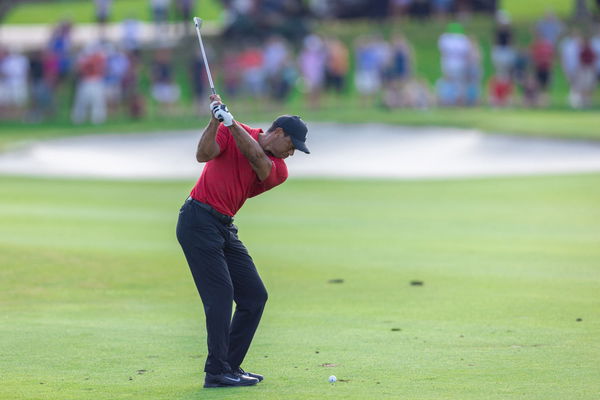
USA Today via Reuters
January 4, 2024; Maui, Hawaii, USA; Tommy Fleetwood hits his fairway shot on the fourth hole during the first round of The Sentry Tournament of Champions golf tournament at Kapalua Golf – The Plantation Course. Mandatory Credit: Kyle Terada-USA TODAY Sports

USA Today via Reuters
January 4, 2024; Maui, Hawaii, USA; Tommy Fleetwood hits his fairway shot on the fourth hole during the first round of The Sentry Tournament of Champions golf tournament at Kapalua Golf – The Plantation Course. Mandatory Credit: Kyle Terada-USA TODAY Sports
The fairway wood is often considered a unique piece of equipment in a golfer’s bag. It promises nearly the same distance as a driver but with the added forgiveness that a typical driver wouldn’t. However, it’s just as difficult to master. But that doesn’t mean you shouldn’t consider adding it to your arsenal. Especially if your primary goal is to lower your handicap.
Watch What’s Trending Now!
Not only is a fairway wood great off the fairway, but it can also be used from the tee or on shorter grass roughs. Courses like the one at Oakmont Country Club might not be the ideal place to use it in the rough. But if you’re looking to find the shorter grass more often, then you can always switch your driver with a 3-wood to get nearly the same result. Having said that, a 3-wood is not the only kind of fairway club you can choose to have in your bag.
There are a few more options to choose from depending on what you’re looking for in your kit. We’re here to discuss 3 of the best fairway woods you can purchase to give yourself an edge against your peers.
ADVERTISEMENT
Top Stories
Scottie Scheffler Makes Critical Health Announcement After He Ended PGA Tour Hiatus

Tiger Woods & Co. Now Have to Think Twice Before Trash-Talking at TGL Following New Update

Charley Hull’s Silent Fight During Divorce Ordeal Comes to Light: ‘Went Through a Lot’

Lexi Thompson Branded ‘Self-Centered’ After Retirement Decision Led to Chaos & Confusion

What Happened to Golf Creator Brad Dalke’s Wife? Health Update Revealed

3-Wood
The 3-wood is the most commonly used fairway wood in golf. From beginners and amateurs to even professionals, have had a 3-wood at least once in their golf kit. Some tend to use it very often, during their weekend breaks or tournaments. Some of the biggest names in golf also carry the fairway wood in their arsenal. We’re talking about pros like Tiger Woods, Bryson DeChambeau, Rory McIlroy, and Jordan Spieth, all have their own set of 3-woods from different brands. The fact that two of them are famous for hitting long-range drives just tells you how valuable a 3-wood can be, not just for distance, but for versatility and control too. Having said that, there are a few advantages and disadvantages to using a 3-wood. The following table should help you determine if it’s the right fairway wood for you:
| Pros | Cons |
| Excellent distance | Difficult to hit from the rough |
| Can be used from the tee and the fairway | Least versatile fairway wood |
| Quite forgiving | Challenging to master |
| Can hit flatter strokes that don’t catch much flight | One of the most expensive types of fairway wood |
ADVERTISEMENT
There are a lot of factors you need to consider when investing in a 3-wood. One of the major ones would be, do you frequent courses that have more par-5 holes? In that case, you would be able to utilize the fullest potential of your 3-wood. Alternatively, you can also give it a try if you want something better than a driver that offers slightly less distance. The most important question you should be asking yourself is, are you skilled enough to learn how to play with a 3-wood? If not, then there is no point in buying one. Having said that, let’s take a look at some of the best 3-woods you can buy.
- TaylorMade Qi35 Fairway Wood
- Ping G440 Max Fairway Wood
- Callaway Elyte Fairway Wood
ADVERTISEMENT

USA Today via Reuters
Dec 19, 2021; Orlando, Florida, USA; Tiger Woods plays his shot from the 16th fairway during the final round of the PNC Championship golf tournament at Grande Lakes Orlando Course. Mandatory Credit: Jeremy Reper-USA TODAY Sports/Reuters
7-wood
The 5-wood and the 3-wood stand to share a lot of similarities, hence why we skipped it, because the 7-wood offers something different. Having said that, what makes a 7-wood unique is that it offers a lot more loft than the alternatives. It is typically angled between 21–24 degrees, which ensures that your ball flies higher. If you are comfortable with your driver, then getting a 7-wood as a replacement for your 3-4 irons is a viable solution. Many top golfers like Xander Schauffele, Dustin Johnson, and Adam Scott have incorporated this piece into their kit because of its versatile nature. Let’s narrow down the pros and cons of getting a 7-wood to improve your game.
ADVERTISEMENT
| Pros | Cons |
| Better launch angle | It can get difficult to hit straight |
| Far more forgiving | Not as precise as long irons |
| Can be used from the tee on par-3s | Doesn’t cover as much distance as other fairway woods |
| A lot more versatile | Mid-range pricing that offers a little less distance |
| Easier to use |
A 7-wood can be great for anyone who doesn’t want to replace their driver but is looking for better options than long irons. However, you need to consider a few things before purchasing a 7-wood. If you play in a particularly windy area often, then the high loft of a 7-wood would play against you. Moreover, you don’t need a high loft if you play on fields that don’t have many tall obstructions like trees or hills. It will be great for courses like Quail Hollow or TPC Sawgrass. But if you are at a place like TPC Craig Ranch or Torrey Pines, then a 3-wood or 5-wood would be better suited for you. Here are a few 7-woods you can choose from if you do decide to purchase them:
- TaylorMade Qi10
- Ping G430 Max
- Callaway Apex UW
ADVERTISEMENT
Utility woods
If you are a bit more skilled at golf and are looking for the benefits of hybrids and the loft of 9-wood or 11-wood, then you can opt for a utility wood. Unlike a high-lofted wood, a utility wood doesn’t limit itself to strokes with high flight. It gives the control of the flight to the golfer as they can decide how high they want to hit the ball. That’s where the skill bit comes in, as the increased workability of the club requires a level of expertise to master. Having said that, a utility wood is great to bridge the gap between a fairway wood and a hybrid wood, as it gives the best of both worlds. However, it does come at a price.
| Pros | Cons |
| Higher workability | Adjustable utility woods are difficult to find |
| Highly versatile | Susceptible to fades or draws |
| Increased forgiveness | Difficult to learn (Can lead to hooks or slices) |
| Can hit long distances | The most expensive option among the rest |
| Improves consistency |
ADVERTISEMENT
With great power comes a greater price. Utility woods don’t come cheap, and a lack of adjustability makes them even more of a risky purchase. For everything it has to offer, you will need to understand that a utility wood is not easy to master. However, it will undoubtedly be one of your best clubs if you do manage to learn how to work it. It’s not only versatile in terms of where you can hit it from, i.e., tee, fairway, or rough. But you can also use them in different types of courses. The decision is up to you. Do you have the skill to adapt to it, the time to learn to adjust to it, or the money to give it a try without a second thought? Either way, if you do decide to get a utility wood, then the Callaway Apex Utility Wood is the best and most commonly purchased one on the market.
ADVERTISEMENT
ADVERTISEMENT
ADVERTISEMENT

